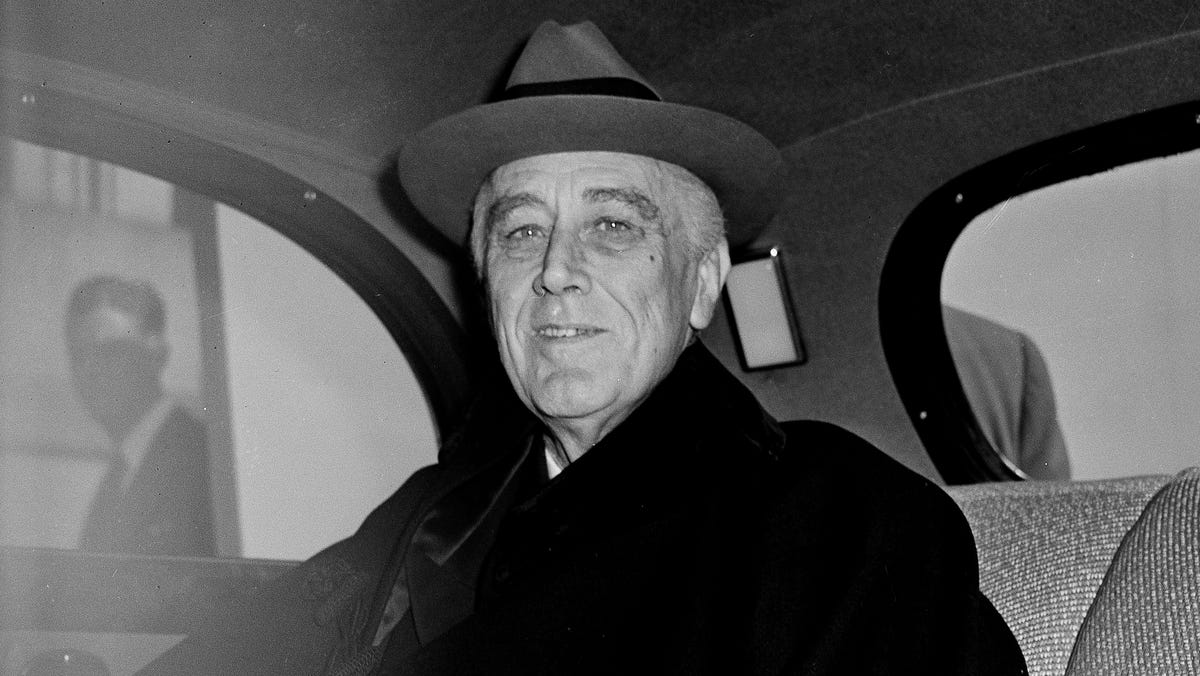Olive oil: Reasons to love and use it that can help with your health
New research from Harvard says adding olive oil to your diet could lower your risk of Alzheimer’s disease, heart disease and cancer.
In 1949, Carla Rollins’ grandparents volunteered for a research study designed to better understand the disease that had killed President Franklin Delano Roosevelt just four years earlier.
Back then, there was some suspicion that high blood pressure might be unhealthy. But Roosevelt’s doctor didn’t consider the President’s rising blood pressure problematic until a few months before his April 1945 stroke. Even then, the doctor had no good tools to bring it down.
Cardiovascular disease had become the leading cause of death in the United States by the late 40s, but little was known about how to prevent or treat it. To learn more, researchers decided to focus on one Massachusetts town, following families like Rollins’ over time.
The study that resulted has informed Americans health for decades. On Friday, the Framingham Heart Study marks its 75th anniversary.
Over three generations, its findings have changed how Americans and their doctors view heart disease and what to do about it. It confirmed the role high blood pressure, high cholesterol, blood sugar and smoking play in the development of heart disease, stroke and dementia among other ailments.
“It really is hard as a cardiologist or even as a physician to think of any area in cardiovascular disease where Framingham hasn’t leant some insight,” said Dr. Thomas Wang, a cardiologist and chair of medicine at UT Southwestern Medical Center.
The study was “foundational” in identfying key risk factors for heart disease, said Dr. Vasan Ramachandran, founding dean of The University of Texas School of Public Health San Antonio and a former principal investigator of the Framingham Heart Study.
It even led to the concept that there are “risk factors” for disease,Ramachandran and others said.
The day he died, Roosevelt’s blood pressure was measured at 300/190 mmHg. At the time, it was considered acceptable for blood pressure to rise with age, as his did.
Today, someone would be considered to have high blood pressure at 130/80. Below 120/80 is considered normal.
“Prior to Framingham we understood relatively little about causal factors related to heart disease and we knew even less about things you could do to prevent it,” said Dr. Daniel Levy, who has been involved in the study since 1984 and wrote a 2005 book about it called “A Change of Heart.”
Data from the first two decades of the Framingham study showed that “if you just take those three cardinal risk factors from Framingham ‒ blood pressure, cholesterol and smoking ‒ if you could eradicate those three factors, it’s estimated we could reduce cardiovascular risk by about 90%,” Levy said.
Identifying risk factors
The study also showed that these risk factors tend to cluster together ‒ people with high blood pressure often have high cholesterol, for example ‒ and the presence of one amplifies the effect of the other, Ramachandran said.
That combination led to a predictive risk score, long called the “Framingham Coronary Heart Disease Risk Score,” that could estimate someone’s risk of a heart attack.
The study was also one of the first to use echocardiograms and stress-testing on large groups of people to show that structural changes can be early warning signs of heart disease, Ramachandran said.
Following healthy people over time allowed researchers to see how risk factors early in life might translate into disease later, said Wang, who wrote about the 65th anniversary of the study along with Ramachandran and Levy. Observing people in real time is more accurate than asking them to remember details from their distant past.
Roosevelt died of a stroke, which the study showed shares the same risk factors as heart attacks, said Dr. George O’Connor, interim director of the Framingham Heart Study.
They’re both diseases of blood vessels. If plaque builds up in vessels of the brain it can lead to a stroke; if it builds up in arteries leading to the heart it can cause a heart attack.
Framingham also helped explain the role atrial fibrillation, a common form of irregular heartbeat, plays in strokes, said O’Connor, a professor of medicine at Boston University. When the heart wavers instead of beating normally, blood can stagnate, forming clots that travel up to the brain.
Knowing risk factors also helped scientists develop treatments for them.
People with atrial fibrillation are now treated with anti-coagulants to prevent blood clots. Tens of millions of Americans take medication for high blood pressure, high cholesterol and to control their blood sugar levels.
“Today, almost anyone, whether president or pauper can have their blood pressure treated effectively for only a few pennies a day,” said Levy, a principal investigator with the National Heart, Lung, and Blood Institute and a former director of the Framingham study.
A lifetime of volunteering
The last of the original 5,209 study volunteers105-year-old Agnes Renzi DeCenzo, died on Monday.
More than 5,100 children of those early participants were added beginning in 1971 as part of the second cohort. Their children started getting added in the early 2000s.
Recognizing that the study’s findings were limited by Framingham’s history as a largely white community, the study added 500 Framingham residents with more diverse backgrounds beginning in the 1990s as the town itself grew and became more diverse. Another 400 participants were added beginning in 2016.
Rollins’ paternal grandmother Mable Savage joined the study on March 21, 1949. Her mother’s parents, William and Esther Monahan, joined on Sept. 2 of that year and her parents Ruth and James Savage almost exactly a year later.
Rollins, who signed on herself at 23 is now an old-timer at 73. Her children both participate and she expects her two oldest grandchildren, now teenagers, will enlist in a few years.
A retired chef living in York, Maine, Rollins said she gets as much as she gives to the study.
“They go over my body all the time and tell me cool stuff,” she said.
She’s had liver tests, stress tests, genetic tests, brain scans, even a hair analysis and blood draw after blood draw ‒ “like there was no tomorrow,” she said. Every four years or so, there’s a 5-hour full-scale analysis, and in between, she’s volunteered for a handful of related research studies.
Scans a decade ago showed Rollins, then in her 60s, had the bones of a 30-year-old.
“If I fall down or something goes weird I just jump right back up and keep on going, because I’ve been told I’m strong,” she said. “I don’t need to live forever, but it’s nice to know I really am okay.”
The study also keeps her connected to the town where her parents grew up across Eden Street from one another. When Rollins drives the two hours to Framingham for the latest exam, she typically stops at St. Patrick’s Cemetery in nearby Natick, where three generations of her ancestors are buried.
“When I go down there for the heart study, I can feel them,” she said.
Framingham in the 1940s and early 1950s was a mostly working-class town of just over 20,000. General Motors and Dennison Manufacturing Company, a paper and stationary supplier, were the biggest employers.
Grandfather Savage fixed looms and “invented stuff.” William Monahan was a veterinarian who taught poultry science at the state university and inspected herds for the U.S. Department of Agriculture.
Rollins, who ran an organic, whole food, vegetarian cafe in York for years, traces her love of cooking to farm visits with her adoring grandfather. The first thing the farmers would do is “make me lots of cool things to eat,” she said. “Everything was homemade and fresh.”
The real message of Framingham
The true message of the Framingham Heart Study is that overall health is tied to healthy eating and other lifestyle factors, said Dr. Dariush Mozaffarian, a cardiologist and professor at the Friedman School of Nutrition Science and Policy at Tufts University.
Yes, high cholesterol and blood pressure are among the warning signs of impending heart disease, he said. But the best way to combat them isn’t with a medicine cabinet full of drugs, but a diet filled with fresh fruits and vegetables and healthy oils, he said.
Studies show that dramatically improving the diets of patients who’ve recently had heart attacks reduces the risk of a repeat occurence by 30% ‒ as much as drugs, Mozaffarian said.
“Lifestyle should be the first thing we should be prescribing in the clinic and it should be the first thing that public health and healthcare systems are focusing on,” he said, “because you’re only in the doctor’s office 30 minutes a year.”
Framingham Heart Study data led some people to decide eating a high fat diet was unhealthy, but early findings actually contradicted that, Mozaffarian said. A Framingham study in women found no link between the amount of fat they ate and their blood pressure levels and another in men found that eating more fat led to a lower risk of stroke.
“Somehow that was missed,” he said. Framingham research “didn’t support a simplistic low-fat or even low-saturated-fat focus.”
Looking ahead
Every trend in cardiovascular disease over the last 75 years has either started or passed through the study.
“The story of Framingham has been the way cardiovascular medicine, risk prediction and our understanding of biology of disease has evolved,” Ramachandran said. “When something became available, Framingham always was proactive and used that technology.”
The study is now one of a number of research projects following large groups of people over long periods of time. The Jackson Heart Study, for example, started in 1998 to track heart disease among African Americans in Jackson, Mississippi.
Framingham, Jackson and other studies often pool their data to include more subjects and more diversity.
The Framingham study has also expanded beyond the heart.
Using brain donations from participants immediately after death, the study has looked at diseases like dementia. It has explored social networks, finding that obesity and smoking clusters among families and friend groups. It has collected stool samples to examine the microbes living within the guts of volunteers to see how these bugs might be impacting human health. And it has taken advantage of the falling cost of genetic analysis to sequence the genes of thousands of participants.
Now, the study is using machine learning to examine aging ‒ trying to explain, for instance, why some people at 60 can have the health of a 40-year-old, while others age faster than normal, said Honghuang Lin, a professor of medicine at the University of Massachusetts Chan Medical School.
One recent study showed that taking more steps a day is healthier than fewer.
The study itself has evolved with the times. Today’s Framingham Heart Study “is not your grandmother’s study,” Ramachandran said. “It’s your grandson’s study.”
Contact Karen Weintraub at [email protected].
Health and patient safety coverage at USA TODAY is made possible in part by a grant from the Masimo Foundation for Ethics, Innovation and Competition in Healthcare. The Masimo Foundation does not provide editorial input.
2023-09-28 18:32:40
#health #study #inspired #FDRs #death #changed #life #America


